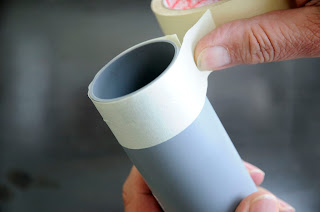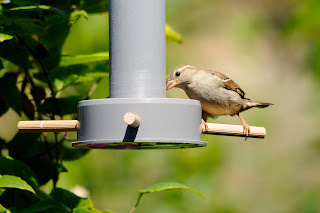Vogelfuttersilo to recreating photographing birds makes a lot of fun. But requires a lot of patience. Corrupt the little fellows but all. With a bit of food to bribe and lure more into the garden. Since I
the book "Birds feeding - the right way" by Professor Dr. rer. I read Peter Berthold and Gabriele Mohr from the Kosmos, I offer to the feathered friends in the summer food. That was long frowned upon time, Professor Berthold recommends but the feeding during the summer.
I have now a very cheap and easily manufactured feed silo was designed and tested in our garden for a few weeks. It is accepted by a whole lot of grain eaters and visited regularly.
To rebuild my feed silo you need the following, available in any hardware store parts.
 |
| as always, click enlarges the photos these |
a 25cm long DN50 drain pipe, a DN100 and DN50 cap (socket cap hot things officially, that sounds but in my opinion somehow stupid ), all made from polypropylene, which is also used in drinks bottles are used. The technical term for this is HT-tube drainage pipes.
A piece corrugated timber with a diameter of 10mm of beech wood. The part you get mostly in the timber department than 1 meter long piece of wood dowels for Herstzellung.
Finally a piece of wire to hang the feed silo. I use a copper wire coated with polymer, such as electricians use it for pulling in conduits. But flowers tie wire, or simply a sufficiently stable, weatherproof cord is to fit.
have everything together for us at the hardware store I paid less than five euros.
to tool you need the following:
a measuring stick,
pencil,
drill with 10mm and 3mm drill,
a fine saw or miter saw to cut the round piece of wood,
about 50cm crepe tape, 3 cm wide,
an A4 sheet of paper and a compass or sign
angle to create the 60-degree angle or 120 ° angle
now ready to go. First they wrapped at the bottom of the DN50 tube with masking tape, then the DN100 cap, as shown on the next two images
with this step we want to win any beauty contests, it only serves the simpler marking on the plastic parts with a pencil. In the end we remove the tape again, anyway.
leaves with a waterproof felt-tip pen can also draw directly on the plastic, without masking tape.
Now we place on our A4 paper with the circle concentric circles, share the circles in six angular segments, each 60 °. We still know from school, create as big circle with a compass, do not change the radius setting, pierce with a compass point on the drawn circle track, and draw an arc mark on the circle. begin at the intersection of Kreibogen and circle the compass point again and mark the next arc on the circle and so on, until we divided the circle into six equal segments exactly. The straight line connecting opposite markers close then just an angle of 60 °.

The cap
DN100 we centrally (for alignment, we use the concentric circles) on the sheet of paper and draw three lines at a distance of 120 ° on the masking tape, perpendicular to the cap base
as we make the 25cm long DN50 pipe centered on the paper and vertical pencil strokes to paint onto crepe, this time six of them, at intervals of 60 °
marking after the vertical, we mark with a yardstick on the DN50 tube, the holes 15mm from the bottom of
same way we deal with the DN100 cap, 15mm from the inside of the bottom
now comes with 10mm drill bit is used (the polypropylene material can be very good work with wood drills). On the marked crosses we put on the 10mm drill bit and drill through. The holes can look messy and should be finished with a sharp knife. Also, a round file, sandpaper or a Rundraspel is suitable. In any case, the burr can be removed cleanly that they do not end up in the stomachs of birds drain
that water penetration kann und keinen Schimmel im Futter verursacht sollte man in den Boden, ganz am äußeren Rand entlang, auch etwa im 60° Winklabstand mit dem 3mm-Bohrer Löcher bohren
die 10mm dicken Buchenholzstangen werden mit der Feinsäge auf 12cm abgelängt
Die Krepppapierstreifen mit den Bleistiftmarkierungen können jetzt von den Kunststoffteilen wieder abgezogen werden.
Mit den 12cm langen Rundhölzern stecken wir jetzt die DN100 Kappe und das DN50 Rohr zusammen. In dem Rohr bleibt jede zweite Bohrung frei, dort sollen die Futterkörner herausrieseln. Wenn wir die 15mm have kept a distance from the lower end of the tube and the cap base exactly, should the wooden perches now be horizontal and the tube exactly to stand by its end on the cap base
the wire are below the upper thickening tie around the tube , twist the intersection points and turn a loop for hanging
in the picture on top seal can be removed. Then, the opening and closing during refilling easier
should be as similar to the following picture the whole thing look
the small upper cap is also very good for filling the feed grains
remains found only a suitable place in the garden and the food container to hang
including photography The assembly has cost me about two hours. After hanging up the container, it took some 12 minutes until the first green Fink has gathered himself. And he has no objection to my photos
a sparrow also been interested
thanks with a loud chirping and put his new surroundings from the food source having
A few notes at the end:
whom the building site to the tube HT dull gray of the show, can the remedied with color. But please be without suitable non-toxic paint and on the external pages that are not directly in contact with food
the remaining open holes, which trickle from the food I drilled with 10mm diameter. This may be too large for fine food, appear for large sunflower seeds a little too small. But I have observed that the birds when they must work hard to stay to work out the grain from the interior for longer and longer are here to observe.
The photographer can only be good.
The size of the holes are adapted to the grain size, either widen with the drill size or the holes after drilling to the round file. But only these feed holes, the others remain, which are scheduled to the perches 10mm tall, or not to keep the logs
For the HT-tube length 25cm I have chosen. Of course you can use longer pipes, it fits in more food. The jigsaw can also reduce the recording volume
A major advantage of my food container much I is that the birds if they do not sit on perches can defecate into the lining and it stays clean
Because everything is just stuck together and no glue was used, you can easily disassemble the whole thing again and clean the parts with very hot water. This should definitely happen from time to time
as already mentioned above I can book by Professor Peter Berthold (to 2004 he was head of the ornithological station Radolfzell) recommend and Gabriele Mohr much. I have paid for € 7.95, it can be ordered from ISBN 978-3-440-11644-9 and always worth its price
then I can just have fun want to replicate and observing and photographing our feathered friends.
I would be very happy if counterfeiters and prospects a note left behind in the form of a comment on this post
Look again purely


























